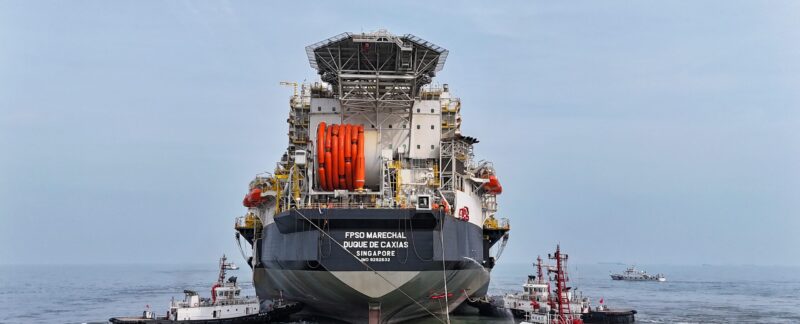The drill ship Marechal Duque de Caxias left this Saturday, February 24, from Yantai, China, heading to the Mero field, operated by Petrobras, at the pre-salt layer of the Santos Basin. The drill ship will be commissioned next September, and is capable of producing up to 180,000 barrels of oil and compress up to 12 million cubic meters of gas every day.
The unit is chartered by Petrobras from MISC and will be part of Mero’s 3rd definitive production system, increasing the field’s installed production capacity to 590,000 oil barrels per day. This production system comprises the interconnection of 15 wells to the unit, 8 oil producers and 7 water and gas injectors, through a subsea infrastructure of 80 km of rigid production and injection pipelines, 47 km of flexible service pipelines and 44 km of control umbilicals.
The rig is classified as an FPSO (floating production, storage and offloading unit, as per its English acronym), will be interconnected to the HISEP equipment, which will separate the oil and gas at the seabed, from where it aims to pioneer the reinjection the CO2-rich gas.
Mero is the third largest field in Brazil in terms in place oil volume (which may be recovered at the reservoir), behind only Tupi and Búzios, also located in the Santos Basin pre-salt layer. In addition to FPSO Duque de Caixas, Petrobras will commission another unit into operation at Mero in 2025.
Unified Mero field operations are carried out by the consortium operated by Petrobras (38.6%), in partnership with Shell Brasil (19.3%), TotalEnergies (19.3%), CNOOC (9.65%), CNPC (9.65%) and Pré-Sal Petróleo S.A (PPSA) (3.5%), as a representative of the Federal Government in the non-contracted area.
PPSA also acts as the contract manager and sells the portion of oil under Governmental law. Mero was the Federal Government’s main oil producer in 2023, producing 11.1 million of the 17 million barrels that the Brazilian Government was entitled to in 2023. There’s a lot more to come!
Click here and learn more about the Brazilian Government’s annual production.


